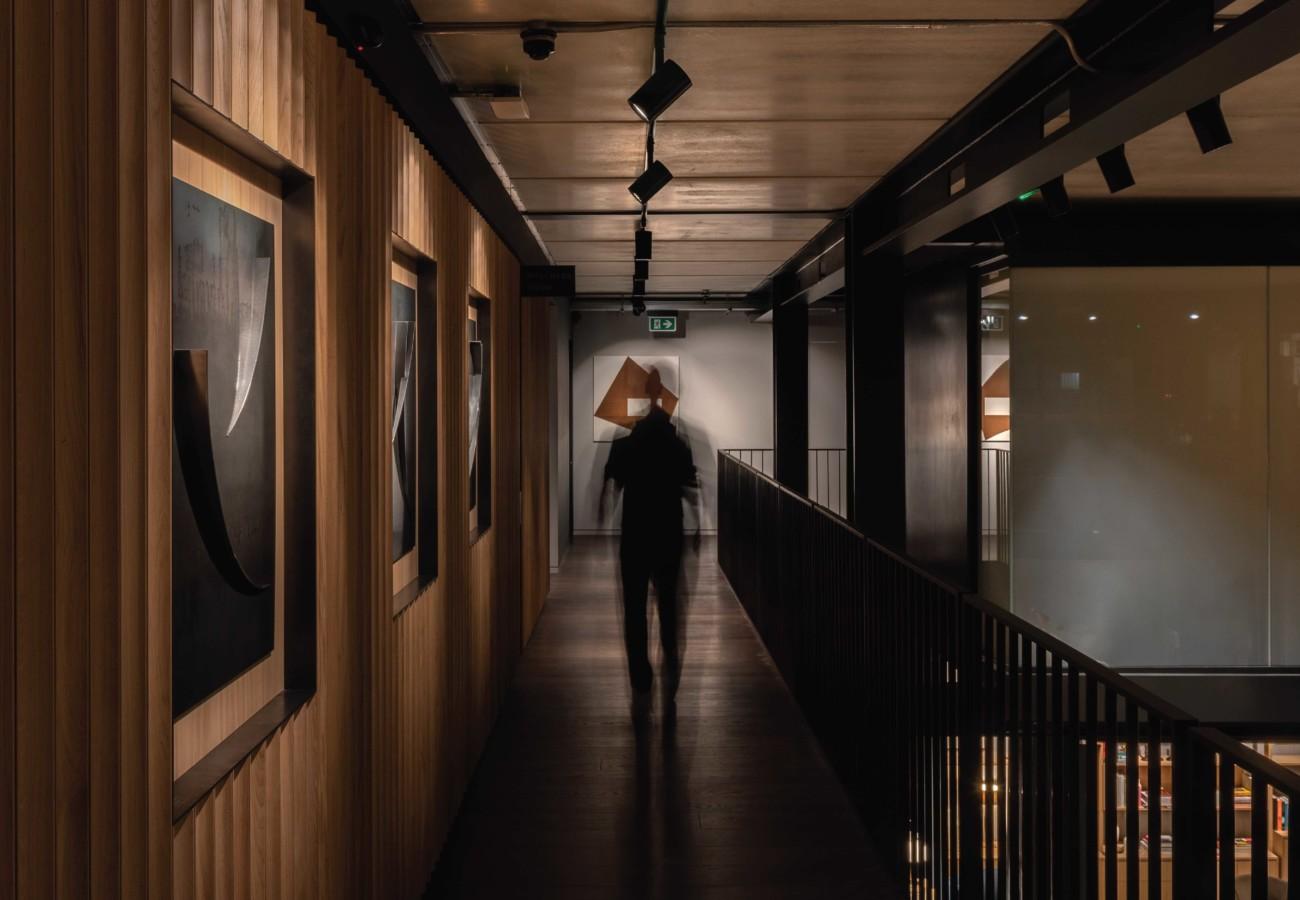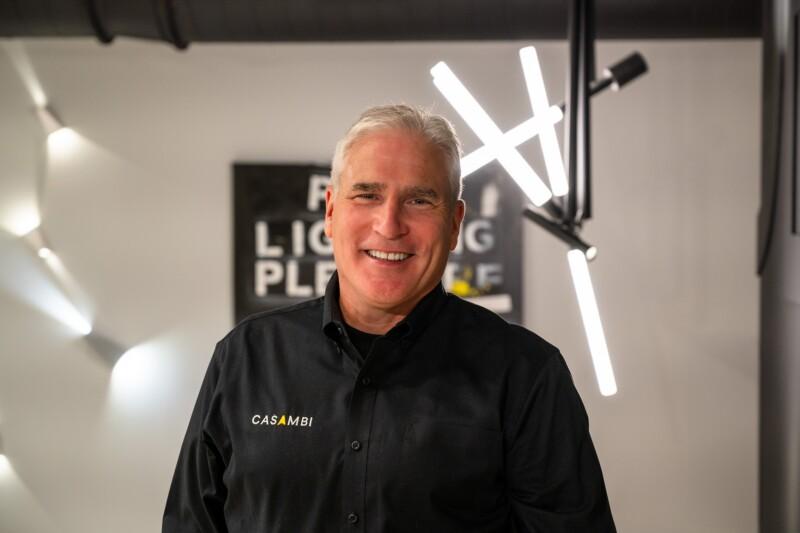ARUP project marks first commercial implementation of wireless emergency lighting

Seeking seamless architectural integration, the new emergency lighting system at DL/78 needed to minimize physical equipment and power containment and introduce a smarter means for testing. Simon Blazey, Strategic Solution Manager at Tridonic, explains how Tridonic’s Casambi-based system delivered:
When Arup collaborated with client, Derwent London, and architects, MSMR, to create a destination workplace on Charlotte Street in London (DL/78), they set out to design a people-centric space – one that would combine the functionality of an art gallery, a café for the general public, a wellness space, a members’ club, and a bookable event space all within a very small footprint.
The lighting design at DL/78 focuses on the human experience by employing techniques that create a relaxed lit environment while providing adjustability for multiple users and conditions – from everyday use to conferences and corporate events. Casambi was chosen to provide a flexible lighting control system to suit the ever-changing needs of the spaces within the unit – the goal of which was to place the power in the hands of users to manipulate the lighting easily and effectively via the smartphone app to suit their needs and then return to everyday settings or a different use in an instant for the next user.
Casambi’s wireless system also played its part in helping the site to achieve green credentials (DL/78 was awarded the BREEAM Excellent Certification and an EPC rating ‘B’) by eliminating the need for control wiring (which utilizes single-use thermosetting plastics) and, with that, removing the need to reroute or install new control cables (which, oftentimes, disturbs the interior decorative finishings) if the fittings are relocated or additional lights are added in the future. In line with this, the emergency lighting also needed to be cognizant of the sustainability drivers while preserving aesthetics and simultaneously catering to all the different use cases within the space. Arup stipulated the need to avoid the installation of a large central battery system, associated control modules, cabling, and lead-acid batteries.
Design-friendly wireless emergency lighting
The Casambi system enabled the implementation of a wireless emergency lighting testing and control setup at DL/78 – which, in fact, became the first commercial implementation of this type of system. Catering to the need for seamless architectural integration, Casambi and Tridonic collaborated to provide a system that minimized physical equipment and power containments, keeping ceilings clear with a rational and simple design.
Tridonic, a world-leading supplier of lighting technology, provides wireless emergency lighting systems based on Casambi technology. Its foundation is a basicDIM wireless system that forms a fail-safe mesh network for robust communication without the need for additional wiring. It can be integrated into pre-existing installations in compliance with current standards and without additional wiring. To meet the requirements of Arup’s specification, the following actions were proposed and implemented on-site.
- To use standard lighting as emergency lighting, Tridonic provided the Tridonic EM Converter LED Pro and basicDIM Bluetooth wireless emergency lighting node for all luminaires (in this instance for Liteplan, Thorn, iGuzzini, and Tamlite).
- They supplied SceneCOM controllers and two Bluetooth gateways to provide standard lighting control which would also allow the end user to run wireless emergency testing. (With the Tridonic SceneCOM evo DA2 controller, every DALI emergency luminaire today or in the future can easily be converted to be used in the wireless emergency system). These were installed in the local electrical cupboard and had a data point connection so the client could access reports. Once commissioned, the controllers act as the ‘brain’ and take over command of the entire lighting solution. The test and system data are accessed via Ethernet from any web browser.
- Pursuant to regulation, every emergency lighting installation needs to be regularly tested and its status documented. This process is in many cases very labor and cost-intensive. Tridonic’s control logic enables the controller to automatically test the individual luminaires integrated into the network and display the status in real-time. The degree of automation offered here considerably reduces the time needed for commissioning and programming the test algorithms.
Simon Blazey, Strategic Solution Manager at Tridonic worked with us on this project;
‘The Tridonic wireless emergency solution can be included and communicate within the mains lighting Casambi mesh and therefore utilizes all the smart wireless commissioning tools. In addition, the ability to talk directly to the sceneCOM controller to automate the testing greatly reduces commissioning time and eliminates the need to visit the site every month to action the emergency test’, he says.
‘The Tridonic sceneCOM controller, which is at the heart of our wireless emergency solution provides, via an onboard HTML page, the ability to schedule the automated emergency tests at any time and at any frequency of test. The controller also has the ability to present the tests to the operator on a dashboard or share via API, BACnet interface, or even in pdf attached to an email’
- Tridonic focused on how best to present the wealth of options of display data to the user, from accessing the emergency reporting locally via connecting directly into the SceneCOM, to integrating to the Building Management System to allow the data to be viewed on the front end, to the provision of links where the reports are emailed to the customer.
‘Tridonic has various options on how we present the test reports for the operator. These options include a BACnet interface and an API interface. However, for this client, they chose to use our EM Link solution, which has the ability to send an email automatically to the operator. This has the emergency test as a pdf attachment embedded within the email’ states Blazey.
Uniquely, the Casambi system enabled the implementation of an emergency lighting testing and control system via Bluetooth. By utilizing new-to-market emergency light fixtures that integrated an emergency battery pack and a wireless controller, Arup was able to eliminate the need for a cumbersome central battery system, associated control modules, cabling, and lead-acid batteries. The addition of a self-testing, reporting emergency system has been a game-changer for wireless lighting technology and interior design, to boot.
Simon informs that since project completion, the uptake of Tridonic’s solution has been fantastic – having made its mark in the UK automated emergency solution market;
‘The industry has been for many years now comfortable with wireless Bluetooth lighting – evidence of this can be seen by the volume and types of projects both Casambi and Tridonic have been involved in. By adding to the already accepted Casambi Bluetooth mesh with wireless emergency lighting from Tridonic, this provides a natural, comfortable, and accepted transition. The main reason for this is that Tridonic is the leading provider of emergency converters – with both its EM Pro range, and the sceneCOM controller, which is an established Dali2 controller. For many years, smart development has been integrating both these well-established products into the leading wireless mesh of Casambi, which is the real game changer.’
For more information on Tridonic’s offering, please contact Simon Blazey, Strategic Solution Sales Manager at Tridonic UK Ltd, +44 (0)7970816591, Email simon.blazey@tridonic.com.
Interested in learning more about Casambi? Drop us a note, and we’ll reach out to you:


